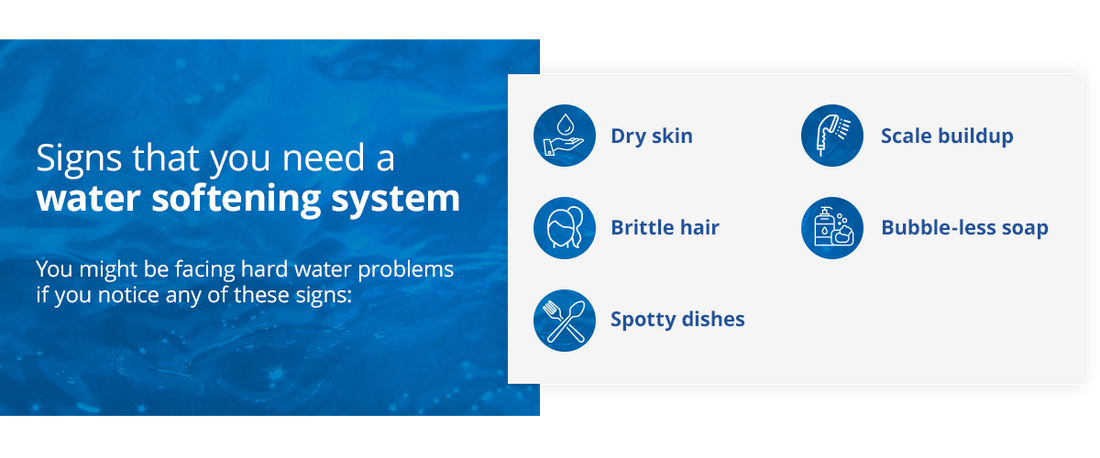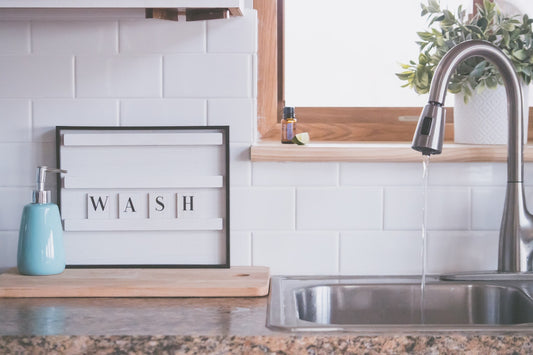“Soft” water is just the opposite of “hard” water, which is water that’s full of a bunch of magnesium and calcium. When magnesium and calcium in the water interact with the surfaces, pipes, and appliances in your home, they start to form limescale. Limescale is this rough, mineral build-up that, if you haven’t seen in your own home, you’ve definitely seen in someone else’s.
Additionally, hard water makes soap “hard” to lather. It isn’t necessarily that the water itself is any harder, physically, than soft water (although that’s technically also true), it’s named “hard water” because it makes things “hard” to clean -- although it’s easy to assume otherwise.
With that said, that’s probably where the term “soft” water came from. Soft water is just water that isn’t hard. A water softener, then, takes hard water and turns it into soft water.
But how do you even know if you have hard water in the first place?
Signs You Have Hard Water
We’ve already touched on a couple signs of hard water, but depending on the severity of the problem, you may or may not be suffering from those exact hard water issues. Here’s a more extensive list:
-
White spots on glasses and silverware after you put them in the dishwasher.
-
Dry skin and hair, no matter what skincare and haircare products you use.
-
Soap scum on sinks.
-
Low water pressure throughout the house.
-
Your clothes come out of the washer not clean.
-
The lifespan of your appliances is lower than it should be.
-
And, of course, you find it hard to lather soap.
According to the US Geological Survey, a solid majority of the United States suffers from some level of hard water, so it’s likely that you do, too. And if you get your water from a well, the problem could be even worse. Most well water contains hardness in excess of 180mg/liter.
Now that you have an answer to the question, “What is soft water?” let’s tackle the second part: “How to Soften Hard Water.”
How to Soften Hard Water Naturally
So, here’s how to make hard water soft.
There are a number of ways you can do it, actually. Let’s start with one of the most popular (but one that’s quickly falling out of fashion, for reasons we’ll discuss).
Ion Exchange Salt-Based Water Softening
A lot of water softeners today are built to perform the process of ion exchange. Magnesium and calcium, the two main minerals that make up hard water, are positively charged. When they interact with a negatively charged resin inside an ion exchange water softener, they cling to it. Eventually, though, the resin runs out, and the magnesium and calcium have nothing to bind to.
That’s why the resin has to be regenerated, and that’s where the salt comes in. The sodium is also positively charged, and when there’s enough of it, it eventually binds to the negatively charged resin, replacing the magnesium and calcium. The hard water is then discharged, and the sodium-filled soft water ends up in your home.
I’m sure you can see why that might be a problem. Sodium isn’t necessarily good for you, especially in a country where 1 in every 3 adults suffers from hypertension. Americans on average eat about 3400mg of sodium per day, which is roughly 150% of the daily recommended value. For your and your family’s health, you probably don’t want to be consuming more, especially in your drinking water.
Furthermore, ion exchange salt-based water softeners waste quite a bit of water. That’s leading to bans across many counties in the United States, particularly in areas of California where drought is common.
Luckily, there are alternatives based on newer technology to ion exchange softening that accomplish the same benefits without as many of the drawbacks.
Template Assisted Crystallization
Arizona State University completed a study that evaluated domestic alternatives to ion exchange softening and found that template assisted crystallization performed just as well as ion exchange at preventing limescale.
What does that mean for your hard water problem? That means you can essentially turn hard water into soft water without actually removing any magnesium and calcium -- just by changing the way that it interacts with surfaces and your skin.
It turns out that you don’t actually need to know how to make soft water in order for hard water to have the same basic principles as soft water.
When the magnesium and calcium interact with the template media in a TAC system, that media changes the structure of the magnesium and calcium so that it remains suspended in water and doesn’t adhere to surfaces.
If you’d like to explore some TAC options that come with a lifetime guarantee or your money back, we have a great line of products for you to check out.
Conclusion: What is Soft Water? And How to Soften Hard Water
Soft water is water that isn’t hard water.
That doesn’t seem like a good answer, but it’s actually one of the clearest. Hard water is water that’s full of magnesium and calcium, making it “hard” for you to lather your soap, for your appliances to function correctly, for your skin to stay young and healthy-looking, and for your clothes to get cleaned properly.
And, since most households in the US suffer from some sort of hard water problem, it wouldn’t be right to call soft water “normal water.” Hard water is, by definition, the more “normal” water.
So, soft water is just water that isn’t hard.
You can make soft water in two primary ways: by replacing the magnesium and calcium with sodium via ion-exchange, or by changing the structural make-up of magnesium and calcium via template assisted crystallization.
Ion exchange comes with its own set of problems, but it might still be a good option if you suffer from exceptionally hard water. For most domestic applications, template assisted crystallization softeners, like the ones we offer at FilterSmart, are even better.







